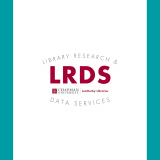New Research Guide for the Center for American War Letters Archive
July 13, 2020
If you’re a seasoned user of the Leatherby Libraries, you’re probably quite familiar with our Research & Study Guides. Compiled by our wonderful subject liaison librarians, they contain links to searches, virtual resources, and lots of great advice on how to perform the best research in a given field. We also offer Research Guides to help Chapman University researchers grapple with current issues, like our Library Content for Online Teaching and Learning guide, and our Black Lives Matter guide. One of our other more recently added guides is one written by Center for American War Letters Archives archivist Andrew Harman. While Research Guides are much more common for academic majors and departments, they’re far less common for archives and collections, which is part of what motivated Andrew to create this one.
Andrew writes that before embarking on this project, he, “thought that archives did not typically have Research Guides but after looking into a collection at Yale University (the American Diplomacy collection in their Manuscripts and Archives), I found a very helpful and succinct Research Guide they use, and I eventually stumbled on others at various institutions.
“Shortly before that, however, is when I decided to do this last fall. While working with students of Dr. Jennifer Keene’s graduate course, “The Soldier’s War,” a part of the Masters Program in War and Society, I discovered that the amount of preparatory information I had provided the professor to get her students prepared was inadequate. Students came in with broad research areas and no real understanding of what they were looking for, let alone how to find the sources that would lead them to success in writing their thirty-page primary source papers. This resulted in longer reference interactions that, though I am happy to spend as much time as needed, may have suffered due to starting from scratch with each student.
“In the Research Guide, I have tried to be as comprehensive as possible while making it easily navigable. I wanted students to go here first for a one-stop shop and step-by-step guide to not only using the archives but conducting historical research using these sources. The Research Guide helps them be prepared to know how to use archives, where to begin and craft a research question, how to find the appropriate sources, and then how to use them in historical research (war correspondence specifically). With that, my hope is that students can come to our first reference interaction armed with the knowledge that can get them on the road to choosing a collection and reading these sources quickly, and ultimately a head start on crafting their papers. After all, their first assignment, a spreadsheet of their sources, is due two weeks into class!”
You can read the new Research Guide here: https://chapman.libguides.com/cawla


